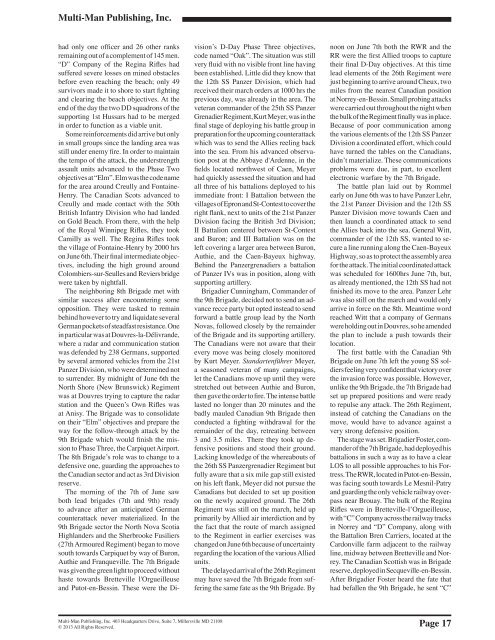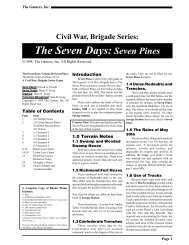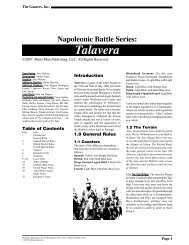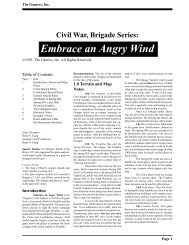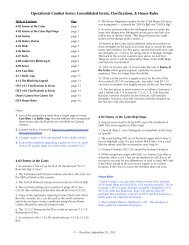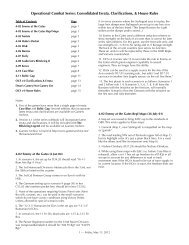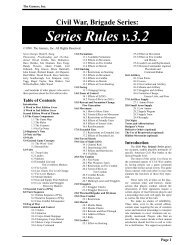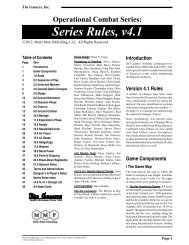Game Specific Rules - MMP Gamers Archive
Game Specific Rules - MMP Gamers Archive
Game Specific Rules - MMP Gamers Archive
Create successful ePaper yourself
Turn your PDF publications into a flip-book with our unique Google optimized e-Paper software.
Multi-Man Publishing, Inc.had only one officer and 26 other ranksremaining out of a complement of 145 men.“D” Company of the Regina Rifles hadsuffered severe losses on mined obstaclesbefore even reaching the beach; only 49survivors made it to shore to start fightingand clearing the beach objectives. At theend of the day the two DD squadrons of thesupporting 1st Hussars had to be mergedin order to function as a viable unit.Some reinforcements did arrive but onlyin small groups since the landing area wasstill under enemy fire. In order to maintainthe tempo of the attack, the understrengthassault units advanced to the Phase Twoobjectives at “Elm”. Elm was the code namefor the area around Creully and Fontaine-Henry. The Canadian Scots advanced toCreully and made contact with the 50thBritish Infantry Division who had landedon Gold Beach. From there, with the helpof the Royal Winnipeg Rifles, they tookCamilly as well. The Regina Rifles tookthe village of Fontaine-Henry by 2000 hrson June 6th. Their final intermediate objectives,including the high ground aroundColombiers-sur-Seulles and Reviers bridgewere taken by nightfall.The neighboring 8th Brigade met withsimilar success after encountering someopposition. They were tasked to remainbehind however to try and liquidate severalGerman pockets of steadfast resistance. Onein particular was at Douvres-la-Délivrande,where a radar and communication stationwas defended by 238 Germans, supportedby several armored vehicles from the 21stPanzer Division, who were determined notto surrender. By midnight of June 6th theNorth Shore (New Brunswick) Regimentwas at Douvres trying to capture the radarstation and the Queen’s Own Rifles wasat Anisy. The Brigade was to consolidateon their “Elm” objectives and prepare theway for the follow-through attack by the9th Brigade which would finish the missionto Phase Three, the Carpiquet Airport.The 8th Brigade’s role was to change to adefensive one, guarding the approaches tothe Canadian sector and act as 3rd Divisionreserve.The morning of the 7th of June sawboth lead brigades (7th and 9th) readyto advance after an anticipated Germancounterattack never materialized. In the9th Brigade sector the North Nova ScotiaHighlanders and the Sherbrooke Fusiliers(27th Armoured Regiment) began to movesouth towards Carpiquet by way of Buron,Authie and Franqueville. The 7th Brigadewas given the green light to proceed withouthaste towards Bretteville l'Orgueilleuseand Putot-en-Bessin. These were the Division’sD-Day Phase Three objectives,code named “Oak”. The situation was stillvery fluid with no visible front line havingbeen established. Little did they know thatthe 12th SS Panzer Division, which hadreceived their march orders at 1000 hrs theprevious day, was already in the area. Theveteran commander of the 25th SS PanzerGrenadier Regiment, Kurt Meyer, was in thefinal stage of deploying his battle group inpreparation for the upcoming counterattackwhich was to send the Allies reeling backinto the sea. From his advanced observationpost at the Abbaye d'Ardenne, in thefields located northwest of Caen, Meyerhad quickly assessed the situation and hadall three of his battalions deployed to hisimmediate front: I Battalion between thevillages of Epron and St-Contest to cover theright flank, next to units of the 21st PanzerDivision facing the British 3rd Division;II Battalion centered between St-Contestand Buron; and III Battalion was on theleft covering a larger area between Buron,Authie, and the Caen-Bayeux highway.Behind the Panzergrenadiers a battalionof Panzer IVs was in position, along withsupporting artillery.Brigadier Cunningham, Commander ofthe 9th Brigade, decided not to send an advancerecce party but opted instead to sendforward a battle group lead by the NorthNovas, followed closely by the remainderof the Brigade and its supporting artillery.The Canadians were not aware that theirevery move was being closely monitoredby Kurt Meyer. Standartenführer Meyer,a seasoned veteran of many campaigns,let the Canadians move up until they werestretched out between Authie and Buron,then gave the order to fire. The intense battlelasted no longer than 20 minutes and thebadly mauled Canadian 9th Brigade thenconducted a fighting withdrawal for theremainder of the day, retreating between3 and 3.5 miles. There they took up defensivepositions and stood their ground.Lacking knowledge of the whereabouts ofthe 26th SS Panzergrenadier Regiment butfully aware that a six mile gap still existedon his left flank, Meyer did not pursue theCanadians but decided to set up positionon the newly acquired ground. The 26thRegiment was still on the march, held upprimarily by Allied air interdiction and bythe fact that the route of march assignedto the Regiment in earlier exercises waschanged on June 6th because of uncertaintyregarding the location of the various Alliedunits.The delayed arrival of the 26th Regimentmay have saved the 7th Brigade from sufferingthe same fate as the 9th Brigade. Bynoon on June 7th both the RWR and theRR were the first Allied troops to capturetheir final D-Day objectives. At this timelead elements of the 26th Regiment werejust beginning to arrive around Cheux, twomiles from the nearest Canadian positionat Norrey-en-Bessin. Small probing attackswere carried out throughout the night whenthe bulk of the Regiment finally was in place.Because of poor communication amongthe various elements of the 12th SS PanzerDivision a coordinated effort, which couldhave turned the tables on the Canadians,didn’t materialize. These communicationsproblems were due, in part, to excellentelectronic warfare by the 7th Brigade.The battle plan laid out by Rommelearly on June 6th was to have Panzer Lehr,the 21st Panzer Division and the 12th SSPanzer Division move towards Caen andthen launch a coordinated attack to sendthe Allies back into the sea. General Witt,commander of the 12th SS, wanted to securea line running along the Caen-BayeuxHighway, so as to protect the assembly areafor the attack. The initial coordinated attackwas scheduled for 1600hrs June 7th, but,as already mentioned, the 12th SS had notfinished its move to the area. Panzer Lehrwas also still on the march and would onlyarrive in force on the 8th. Meantime wordreached Witt that a company of Germanswere holding out in Douvres, so he amendedthe plan to include a push towards theirlocation.The first battle with the Canadian 9thBrigade on June 7th left the young SS soldiersfeeling very confident that victory overthe invasion force was possible. However,unlike the 9th Brigade, the 7th Brigade hadset up prepared positions and were readyto repulse any attack. The 26th Regiment,instead of catching the Canadians on themove, would have to advance against avery strong defensive position.The stage was set. Brigadier Foster, commanderof the 7th Brigade, had deployed hisbattalions in such a way as to have a clearLOS to all possible approaches to his Fortress.The RWR, located in Putot-en-Bessin,was facing south towards Le Mesnil-Patryand guarding the only vehicle railway overpassnear Brouay. The bulk of the ReginaRifles were in Bretteville-l’Orgueilleuse,with “C” Company across the railway tracksin Norrey and “D” Company, along withthe Battalion Bren Carriers, located at theCardonville farm adjacent to the railwayline, midway between Bretteville and Norrey.The Canadian Scottish was in Brigadereserve, deployed in Secqueville-en-Bessin.After Brigadier Foster heard the fate thathad befallen the 9th Brigade, he sent “C”Multi-Man Publishing, Inc. 403 Headquarters Drive, Suite 7, Millersville MD 21108© 2013 All Rights Reserved.Page 17


